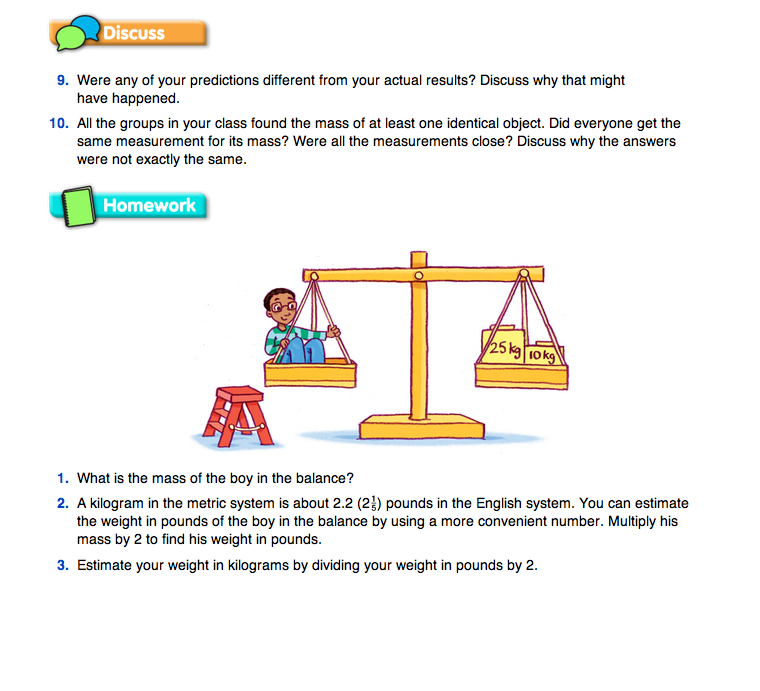Upon completion, have a discussion about the students' measurements.
The discussion should focus on two important issues:
- Does the larger of two objects always have a larger mass? (No)
Compare the measurements of a large, light item and a small, heavy item as an example. Students should see that this is a false assumption. See TIMS Tip.
You can illustrate that an object with a larger volume (an object that takes up more space) can have less mass than a smaller object by showing students a large piece of styrofoam and a small heavy object such as a steel sphere.
- How do the groups' measurements for the common objects compare?
Display each group's measurement for the common object so that students can compare the results. Question 10, which asks if everyone got the same measurement for the identical object, should spark an interesting discussion.
- Is one value more common than the others?
- Is there some value that the numbers cluster around?
- Do any values seem unreasonable?
- Why didn't we all get the same answer? (Possible responses: somebody made a mistake; the standard masses were added incorrectly; the balance was not level.)
- How can you decide which measurements are reasonable? (Possible response: Most of our measurements fall within a certain range. This measurement does not. I don't think that measurement is reasonable.)
- How can we correct this error? (Possible response: We can redo the measurements that do not fall within the cluster range and measure very carefully. We need to make sure the balance is leveled before measuring.)
- Do you think we can make perfectly accurate measurements all the time? Why or why not? (Possible responses: Probably not. It is hard to measure perfectly with the balances. A little error is hard to avoid. The standard masses may be a tiny bit bigger or smaller than what they say they are.)
Once all the unreasonable measurements are taken care of, some variation still remains. This reasonable variation is the product of measurement error. (See the Content Note.) It is important to stress that measurement errors are different from making mistakes and that some measurement error is unavoidable. However, we always try to keep measurement error as small as possible. At this point, you can deal with the notion of “too much error” in an informal way.
Using the common object as an example, ask:
- Let's try to decide which measurements are “close enough” for the [common object]. What do you think would be “too much error”?

Measurement Error. When measuring mass, there are three potential sources of measurement error.
- Perhaps the mass of an object is not a whole number of grams. For instance, let's suppose a calculator's mass is 97.5 grams. The standard masses being used allow the groups to measure only to the nearest whole number. Therefore, some students will measure 98 grams while others will measure 97 grams.
- The two-pan balances are not mechanically precise.
- The standard masses may have slight errors in their mass.
What's Close? The most fundamental idea about closeness is that it is a relative idea. We can consider ratios or percentages to help us know if we are “close enough,” and in general using 10% as a standard of closeness is a good place to start. However, developing this concept requires time and exposure to many experiences. Third-grade students do not need a clear standard to determine measurement error or whether or not a measurement is reasonable. They simply need to be able to begin to think generally about the reasonableness of a measurement. What is a measurement that is “close enough?”
Let students discuss the issue and decide what they will call “close.” Guide students to discover the notion that closeness is relative: a 2-gram error in the measurement of a 100-gram object is reasonable while a 2-gram error in the measurement of a 10-gram object might not be.
The Homework section in the Student Guide can be assigned after Part 2. Students will need to bring a small item from home to mass in Part 3. The item should be small enough to fit into their hands.














